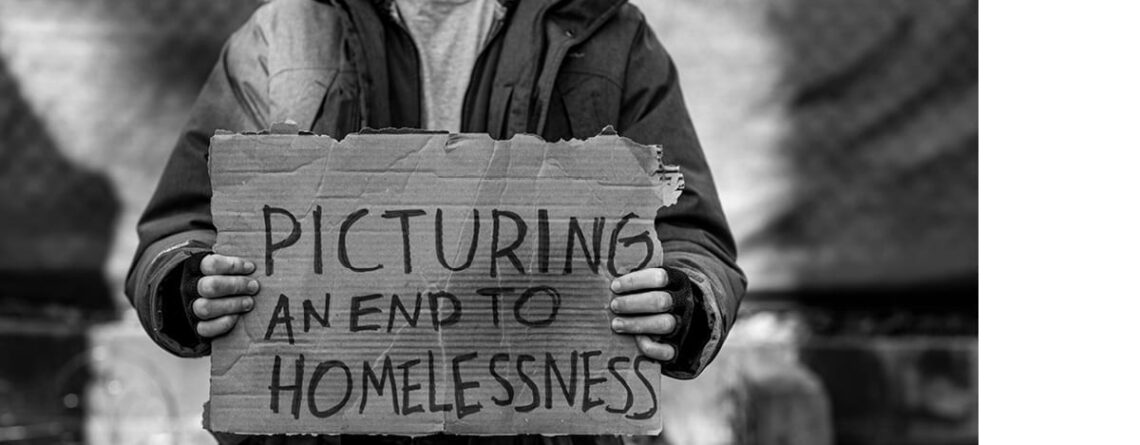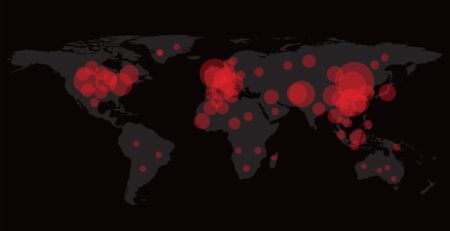Photo by Steven Thackston
SOCIAL WORK PROFESSOR ELIZABETH BECK HAS LONG GRAPPLED WITH THE QUESTION: HOW CAN WE SOLVE AMERICA’S HOMELESSNESS PROBLEM? IN A NEW BOOK, SHE LOOKS TO THE PAST FOR ANSWERS.
Photo by Steven Thackston
SOCIAL WORK PROFESSOR ELIZABETH BECK HAS LONG GRAPPLED WITH THE QUESTION: HOW CAN WE SOLVE AMERICA’S HOMELESSNESS PROBLEM? IN A NEW BOOK, SHE LOOKS TO THE PAST FOR ANSWERS.

Photo by Steven Thackston
written by Max Blau
written by Max Blau
Beck, then a Pittsburgh high school student, was excited — it was the first time she had been there. But as they left, her mother issued a surprising word of caution: that in New York she might encounter people living on the street. Before then, Beck had never heard of homelessness, let alone seen it with her own eyes.
“It can be difficult for Americans born after the mid-1970s to understand that widespread homelessness was not a normal part of our world,” says Beck. “Up until the 1980s, homelessness was typically episodic, with people becoming unsheltered when the country experienced economic downturn, rather than a chronic, ongoing problem.”
The memory of that trip never left her mind. In the years that followed, as America’s homeless population soared, Beck embarked on a lifelong quest to work with what she calls the “forgotten and invisible.” While the scope of her research has expanded to focus on trauma, mass incarceration, restorative justice and community development, Beck, a professor of social work at Georgia State’s Andrew Young School of Policy Studies, has never stopped thinking about how homelessness has transformed into a steady fixture of American life.
She recently co-authored a book, “The Homeless Industry: A Critique of U.S. Social Policy,” with Pamela Twiss, a professor of social work at California University of Pennsylvania. The book chronicles the economic and political forces that first contributed to the rise of homelessness and examines how long-term efforts to curb homelessness have been thwarted by inadequate funding, poor implementation of policies and the country’s traditional response to poverty. (Over the years, national polling has found that most Americans say poverty is more likely to be caused by personal failures, such as a lack of motivation or drug abuse, than structural forces, such as a shortage of jobs.)
Beck and Twiss believe America can still end homelessness. But future solutions will require officials, providers, researchers and advocates to revisit the failures of the past. They say a shift in priorities and perspective is required, one as dramatic as the rise of homelessness itself.
Beck, then a Pittsburgh high school student, was excited — it was the first time she had been there. But as they left, her mother issued a surprising word of caution: that in New York she might encounter people living on the street. Before then, Beck had never heard of homelessness, let alone seen it with her own eyes.
“It can be difficult for Americans born after the mid-1970s to understand that widespread homelessness was not a normal part of our world,” says Beck. “Up until the 1980s, homelessness was typically episodic, with people becoming unsheltered when the country experienced economic downturn, rather than a chronic, ongoing problem.”
The memory of that trip never left her mind. In the years that followed, as America’s homeless population soared, Beck embarked on a lifelong quest to work with what she calls the “forgotten and invisible.” While the scope of her research has expanded to focus on trauma, mass incarceration, restorative justice and community development, Beck, a professor of social work at Georgia State’s Andrew Young School of Policy Studies, has never stopped thinking about how homelessness has transformed into a steady fixture of American life.
She recently co-authored a book, “The Homeless Industry: A Critique of U.S. Social Policy,” with Pamela Twiss, a professor of social work at California University of Pennsylvania. The book chronicles the economic and political forces that first contributed to the rise of homelessness and examines how long-term efforts to curb homelessness have been thwarted by inadequate funding, poor implementation of policies and the country’s traditional response to poverty. (Over the years, national polling has found that most Americans say poverty is more likely to be caused by personal failures, such as a lack of motivation or drug abuse, than structural forces, such as a shortage of jobs.)
Beck and Twiss believe America can still end homelessness. But future solutions will require officials, providers, researchers and advocates to revisit the failures of the past. They say a shift in priorities and perspective is required, one as dramatic as the rise of homelessness itself.

Before Beck’s trip to New York, homelessness was invisible to her. The daughter of two professors, each active in the Civil Rights Movement, Beck had been raised to spot signs of injustice in the world. Yet she doesn’t recall seeing homeless people in her hometown of Pittsburgh. Her lack of awareness wasn’t uncommon: The federal government wouldn’t even begin counting the national homeless population until the early 1980s. The first reports estimated that between 250,000 and 1 million Americans lacked housing.
Around the same time, after graduating from Ohio University, Beck moved to Washington D.C., and got a job waiting tables at a restaurant. Immediately, she noticed “astonishing numbers” of people living and dying on the streets of America’s capital. Beck had so many questions about their experiences — Who were they? How did they become homeless? What was their daily life like? — that she began volunteering at a city shelter. Soon, she was hired to work at the shelter’s day center.
Beck also volunteered with the Community for Creative Non-Violence (CCNV), an advocacy group pressuring Congress to provide aid for homeless assistance. In 1984, she moved into a women’s shelter at the corner of 2nd and D streets operated by CCNV. As the coordinator of the overcrowded and under-resourced shelter, she worked as many as 70 hours a week. She often encountered unpredictable emergencies, like the time a shelter resident delivered a baby on the premises. Despite the substandard conditions, Beck took great pride in caring for the women, even if it was in small ways that at times seemed insignificant.
“There were few ways we could actually help someone,” Beck writes in the book. “But, sometimes, we did. Sometimes a woman just needed shelter for a few nights before she received her first paycheck. Rarely, despite consistent advocacy on the part of staff, we were able to help residents secure a spot in a 28-day treatment program for addiction, but the lack of aftercare often resulted in relapse. Occasionally, we were able to help women transition from the shelter after working with them for a very long time to get their disability and Social Security checks. My general feelings of helplessness were such that I became an expert of delousing, as this allowed me to make a real difference in the quality of someone’s life.”
Beck knew the work was urgent and necessary. Living unsheltered not only had the potential to be a death sentence, particularly during the frigid D.C. winters, it was also linked to higher rates of mental illness, substance misuse and infectious disease.
As Beck oversaw the shelter, she observed what she calls an “embittered struggle” between CCNV and the Reagan administration, as each tried to influence the public on what the government’s role should be in addressing homelessness. At the core of this fight, Beck and Twiss write, was the U.S. government’s embrace of an ideology known as neoliberalism, which promoted fiscal austerity, deregulation and the reduction of government spending.
Federal data suggest the safety net programs can lift millions out of poverty. Research shows that the reduction of those programs can expose families to increased housing instability, a precursor to homelessness. By the end of the Reagan-era recession, some experts estimated the U.S. homeless population had quadrupled.
“Homelessness is not accidental,” Beck says. “When you slash major safety net programs, cut support for the poor and don’t ensure an adequate supply of affordable housing or subsidies for working people, you end up with more homeless people. And that’s what happened.”
Higher rates of homelessness, experts have found, come with a huge price tag. A 2006 study estimated that providing housing for 150,000 chronically homeless individuals — an estimated 5 percent of the total homeless population that year — could save nearly $8 billion in healthcare costs and shelter space.
Beck’s involvement with the CCNV coincided with the most contentious era of homelessness advocacy in modern American history. To raise support for an effort to convert a vacant federal building into shelter space, the group’s leader, Mitch Snyder, an ardent agitator who helped elevate homelessness into national consciousness, fasted for 51 days, a saga that culminated with a “60 Minutes” segment. (Snyder won, and the building was converted.)
Congress was also pressured into passing a series of smaller emergency relief bills, followed by what remains the most influential piece of homelessness policy of the past generation: the Stewart B. McKinney Act of 1987, a federal law to establish and fund assistance programs for homeless people.
The McKinney Act authorized $1 billion for homeless assistance. But advocates remained frustrated by the lack of funding for prevention measures, such as funding to prevent evictions, preserve low-income housing and provide the mentally ill with adequate shelter.
“The McKinney Act was supposed to have had a much larger vision,” Beck says. “That vision got lost.”
Photo by Ben Rollins
Photo by Ben Rollins
In addition to her work on homelessness, Beck also works as a principal investigator for the Georgia Division of Family and Children Services (DFCS). For the past eight years, Beck has received $1 million in grant money to support veteran employees with advanced training in how to deal with sensitive issues ranging from working with LGBTQ youth to helping fathers talk to foster kids about sex.
“When somebody is in a traumatic state, we try to help employees understand why traditional techniques might not work,” Beck says.
Over the past two years, she has also received $3.5 million to expand the work with DFCS into what’s known as the Child Welfare Training Collaborative. The statewide effort educates DFCS’ local community partners — including police officers, school leaders, judges and healthcare providers — on the effects of trauma on child brain development. In bringing these stakeholders together, the collaborative creates a space where information is provided about the most pressing issues facing children, as well as strategies to build resilience within families.
“It puts everyone on the same page: that sometimes kids’ behavior that seems inexplicable can be explained by looking at brain development and the effects of toxic stress,” Beck says.
Photo by Ben Rollins
In the late 1980s, after helping to open a transitional housing facility, the first of its kind in Washington D.C., Beck left to enroll in a Ph.D. program in social work at the University of Pittsburgh. Soon after finishing her dissertation, in the mid-1990s, she joined Georgia State’s nascent social work program.
“I was deeply impressed with what Georgia State was trying to do in terms of its community partnerships,” Beck said. “The university reached out and asked what kinds of skill sets were needed in the community and what the school could provide.”
During Beck’s time at Georgia State, she has expanded her research beyond homelessness to study how state lawmakers’ views of poverty affect their support for government assistance for families, the role of restorative justice in social work and how family members of those who have committed capital crimes experience grief.
In 2007, she co-authored “In the Shadow of Death,” a book focused on the stories of death row inmates’ family members, to illustrate the broader idea of restorative justice, a concept that encourages offenders to be rehabilitated by fostering mediation with the people and communities they harmed. For the past several years, she’s also been the principal investigator on a large training initiative for Georgia’s Department of Child and Family Services.
In 2014, the Society for the Study of Social Problems announced that its annual meeting would focus on the half-century since Lyndon B. Johnson’s “War on Poverty” in the 1960s. Beck presented an abstract — “From Poverty to Psychiatry: How Social Justice Got Lost in the Movement to Address Homelessness” — that analyzed the response to the homelessness crisis of the 1980s.
Soon after, a book editor called to ask: Would you write a book on homelessness?
“So much of the story wasn’t told,” Beck says. “By going back to the beginning, I felt I could influence officials to make more informed decisions about policies.”
When Beck signed on to write “The Homeless Industry,” she reached out to Twiss, a fellow University of Pittsburgh alum who had traveled in similar homeless advocacy circles. Now both social work professors, they agreed on a holistic portrayal of the homeless advocacy movement of the 1980s.
“We didn’t want to end up laying blame with a particular set of people,” says Twiss, “but show there were many parts and people that led to where we ended up.”
To fully understand the rise of homelessness in the 1980s, they read through hundreds of newspaper stories, academic journal articles and reports from advocacy organizations. They pored over government documents, including congressional hearings and notices from the Federal Register, the daily journal of new federal rules and regulations. And they spent time at Georgia Washington University, reading through the papers of Snyder and other CCNV members who donated their records to the special collections library there.
After three years of research, Beck and Twiss identified a set of five core factors they argue gave way to the rise and persistence of homelessness. One, they say, was a historical view that blamed poor people for their life circumstances. Two, politicians began to embrace neoliberal economic and social policies that disproportionately harmed low-income, working-class and black individuals. Three, compromises in policy reforms allowed homelessness to be treated as an emergency, instead of an inevitable consequence of current policies. Four, policymakers framed homelessness as a psychiatric problem rather than a problem rooted in a nationwide affordable housing shortage. And finally, they argue that the creation of a large social service sector formalized what became a “homelessness industry.”
Beck and Twiss also advocate for three kinds of policy changes they say must happen in order to not just end homelessness but also prevent it in the future. First, officials should increase rent subsidies for the poor or even create a universal housing voucher program, in which renters would be required to spend just 30 percent of their income on housing. They say there also needs to be a nationwide minimum wage increase, along with other policies that reduce economic disparities. Finally, they argue in favor of a universal healthcare system that covers mental health conditions. To accomplish these goals, they encourage the adoption of a framework that would include housing as part of a wide set of guaranteed human rights.
Across the country, Beck points to some state and local policies that could serve as a template elsewhere in the fight against homelessness. Nineteen states and 24 cities have recently raised the minimum wage. In some places, including Seattle and San Francisco, it has increased to $15 an hour. In states like Illinois and Connecticut, lawmakers have also passed policies to protect people experiencing homelessness from facing discrimination based on their housing status.
Beck and Twiss acknowledge that without more federal funding for ambitious solutions, progress toward ending homelessness will be limited. The authors also doubt that radical policy shift will happen without a radical shift in the way Americans view poverty.
“How we view the poor, in a society that really values individuals who can pull themselves up by the bootstraps, colors our response to homelessness,” Twiss writes. “It’s a shame that we don’t talk about the mismatch between income and resources and housing costs.”
Or as Beck puts it: “We must return to the values that honor our shared responsibilities to each other.”












Leave a Reply